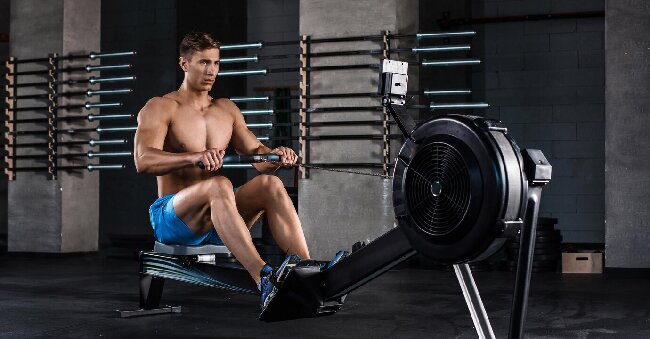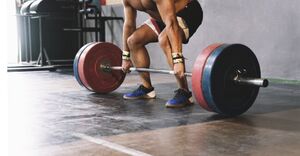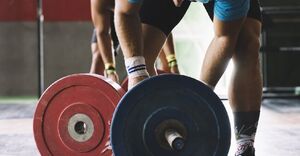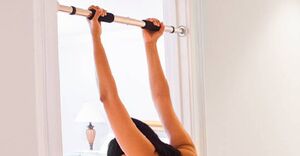
Powerful Tips for Mastering Rowing Machine Workouts: A Complete Guide [2024]
If you’re looking for a full-body workout that’s both effective and low-impact, look no further than a rowing machine.
In this complete guide to rowing machine training, we’ll cover everything you need to know about this versatile piece of equipment. From how it works and the muscles it targets, to the benefits of using a rowing machine and how to use it safely and effectively, we’ve got you covered.
Whether you’re new to rowing or a seasoned pro, this article will help you sculpt the perfect body with a rowing machine.
What Is a Rowing Machine?
A rowing machine, also known as an indoor rower, is a popular fitness equipment designed to simulate the action of rowing in a watercraft.
The design of a rowing machine usually includes a sliding seat, footrests, a handle attached to a cable and a flywheel that provides resistance. This allows users to engage in a full-body workout that targets arms, legs, back, and core muscles.
The functionalities of a rowing machine make it an excellent choice for cardiovascular exercise, muscle toning, and calorie burning. It offers a low-impact workout, making it suitable for people of all fitness levels. The rowing machine provides a variety of resistance levels, allowing users to adjust the intensity of their workout according to their preferences and fitness goals.
How Does a Rowing Machine Work?
A rowing machine operates by utilizing a combination of resistance and rowing technique to simulate the motion of rowing on water.
Proper form is essential for effective rowing, involving a straight back, engaged core, and fluid arm and leg movements. The resistance level on the rowing machine can be adjusted for a more challenging workout, simulating different water conditions. By powering through the legs and pulling strongly with the arms, multiple muscle groups are engaged for a full-body workout. Maintaining correct technique not only maximizes the benefits of rowing, but also minimizes the risk of injury.
What Muscles Does a Rowing Machine Target?
A rowing machine effectively targets a wide range of muscles, including those in the upper body, lower body, and core, providing a comprehensive full-body workout.
Engaging in a rowing workout activates the latissimus dorsi, rhomboids, and trapezius in the upper body, while the lower body muscles such as the quadriceps, hamstrings, and glutes are also put to work. This makes it a great full-body exercise that targets multiple muscle groups.
At the same time, the core muscles, including the abs and obliques, play a crucial role in stabilizing the body throughout the rowing motion. This not only helps improve balance and posture, but also makes rowing a highly effective exercise for toning and strengthening the core muscles.
Upper Body Muscles
Rowing exercises engage and strengthen the upper body muscles, including the arms, shoulders, and back, promoting greater strength and endurance.
The repetitive pulling motion of rowing targets the biceps and triceps, developing impressive arm strength. The constant resistance against the water or a rowing machine challenges the deltoids and upper back, enhancing their endurance and power.
This comprehensive engagement of upper body muscle groups not only fosters muscular strength and endurance but also contributes to improved posture and reduced risk of injury in everyday activities.
Lower Body Muscles
The lower body muscles, such as the legs and glutes, are majorly engaged during rowing sessions, contributing to enhanced power and strength.
The large muscle groups involved in rowing are essential for propelling the rowing motion. When a rower pushes off with their legs, the quadriceps, hamstrings, and calves work together to generate powerful and efficient movements. The glutes also play a crucial role by stabilizing and driving the hips forward, allowing for maximum force to be applied to the rowing machine. This coordinated effort not only builds strength and endurance but also reduces strain on the upper body, creating a balanced and effective full-body workout experience.
Core Muscles
Rowing machine workouts play a crucial role in strengthening the core muscles, enhancing stability, and promoting improved posture.
Engaging the core muscles while rowing is essential for maintaining proper body alignment and preventing excessive strain on the lower back. By activating the core, the body is able to stabilize and support itself during the rowing motion, reducing the risk of injury and improving overall performance.
A strong core contributes to better balance and coordination, allowing for more efficient and powerful rowing strokes. Proper engagement of the core muscles also promotes a healthy posture, reducing the likelihood of slouching and facilitating a more upright and aligned body position.
What Are the Benefits of Using a Rowing Machine?
Utilizing a rowing machine offers a multitude of benefits, including a comprehensive full-body workout, low-impact exercise, and improved cardiovascular health.
Rowing engages major muscle groups such as the legs, back, arms, and core, making it an efficient way to build strength and endurance.
The smooth gliding motion of rowing minimizes stress on the joints, making it an ideal low-impact exercise for individuals of all fitness levels. The rhythmic nature of rowing promotes heart health by increasing cardiovascular endurance and improving overall stamina.
Cardiovascular Health
Rowing machine workouts significantly contribute to enhancing cardiovascular health, improving endurance, and building stamina.
Rowing provides a full-body workout that engages major muscle groups, including the legs, back, and core. It also elevates heart rate and improves lung capacity. This low-impact exercise is suitable for individuals of all fitness levels.
The consistent motion of rowing can boost cardiovascular fitness, reduce the risk of heart disease, and improve circulation throughout the body. Regular rowing sessions can lead to a stronger, more efficient heart and overall well-being.
Full Body Workout
A key benefit of using a rowing machine is the attainment of a full-body workout, effectively targeting muscles and facilitating muscle toning through resistance training.
This low-impact, high-intensity workout engages muscles in the arms, back, shoulders, and legs, providing a holistic approach to muscle toning and strength building.
Rowing also promotes cardiovascular health, improving endurance and stamina. The fluid and controlled motion of rowing ensures that various muscle groups are activated, creating a comprehensive workout experience. The resistance provided by the machine ensures that muscles are constantly challenged, promoting growth and definition over time.
Low Impact Exercise
Rowing machine exercises offer a low-impact workout option, making it a joint-friendly and accessible form of exercise for individuals with varying fitness levels.
The smooth, fluid motion of rowing minimizes stress on the knees, hips, and ankles, making it an ideal choice for those with joint concerns.
Its adaptable resistance levels also cater to beginners and advanced athletes alike, providing a full-body workout without putting undue strain on the body.
Whether seeking cardiovascular improvement or overall strength development, rowing serves as an effective and sustainable option for individuals looking for a workout with minimal impact on their joints.
How to Use a Rowing Machine Safely and Effectively?
Ensuring the safe and effective use of a rowing machine involves mastering proper rowing technique and form, prioritizing safety measures, and incorporating interval training for enhanced effectiveness.
This multifaceted approach to rowing ensures that individuals not only maximize the benefits of the exercise but also minimize the risk of injury.
When focusing on technique mastery, it is crucial to maintain a strong and stable core, engage the legs, and execute a smooth, controlled stroke. Safety considerations encompass paying attention to body alignment, avoiding overexertion, and using proper footwear.
Introducing interval training adds a dynamic element, requiring varying levels of intensity and recovery intervals to push endurance and foster improvements in cardiorespiratory fitness.
By mastering these elements, individuals can harness the full potential of their rowing machine workouts.
Proper Form and Technique
Mastering proper form and technique is essential for maximizing the benefits of rowing machine workouts. This emphasizes the importance of correct posture and efficient rowing strokes.
This adherence to good form ensures that the back and shoulders remain in a healthy alignment, reducing the risk of strain or injury.
Focusing on efficient movement patterns minimizes wasted energy, allowing for a more productive workout.
Maintaining the right posture and executing precise rowing strokes contributes to a full engagement of the targeted muscles, resulting in a more effective cardiovascular and strength-building exercise.
Adjusting Resistance Levels
Adapting the resistance levels on a rowing machine allows users to tailor the intensity of their workouts, enabling personalized and effective training regimens.
This customization is essential for individuals looking to optimize their training experience. It enables them to challenge themselves at the appropriate level and progress over time.
The ability to adjust resistance levels also ensures that different muscle groups are adequately targeted, leading to a more comprehensive and balanced workout. By incorporating varying levels of resistance, users can effectively simulate different water conditions, enhancing the authenticity of their rowing experience while fine-tuning their strength and endurance.
This versatility in resistance adjustment ultimately contributes to the overall effectiveness of rowing machine workouts.
Incorporating Interval Training
Incorporating interval training into rowing machine workouts enhances cardiovascular endurance, performance, and overall workout efficiency, fostering optimal training outcomes.
This type of training involves alternating between high-intensity bursts and lower-intensity recovery periods, pushing the heart rate to peak levels and then allowing it to lower.
This process not only improves cardiovascular health but also enhances the body’s ability to utilize oxygen effectively.
By challenging the body in this manner, rowers can significantly boost their stamina, speed, and overall performance, making interval training a valuable addition to any rowing workout regimen.
How to Create a Rowing Machine Training Plan?
Developing an effective rowing machine training plan involves setting clear fitness goals, establishing a structured training schedule, diversifying workouts, and tracking progress for continuous improvement.
To optimize readability and SEO, it’s advisable to break paragraphs into concise, easily digestible sentences. By understanding your current fitness level and determining what you want to achieve, you can tailor your rowing machine workouts to target specific muscle groups and improve cardiovascular endurance.
Scheduling your sessions consistently ensures regularity and progress, while incorporating different rowing techniques, resistance levels, and intervals adds variety and challenges your body in new ways. Tracking metrics such as distance, time, and intensity allows you to monitor improvement and adjust your plan accordingly, keeping you motivated and engaged in your fitness journey.
Setting Goals
Setting specific and achievable fitness goals forms the foundation of an effective rowing machine training plan, driving motivation and tracking progress towards enhanced performance.
Setting clear goals for rowing machine workouts can provide a sense of purpose and direction, increasing motivation and commitment to the training regimen. By targeting specific milestones like distance, time, or resistance, rowers can measure their progress and see improvements in their fitness levels.
Goal setting also encourages individuals to push their limits, leading to enhanced performance and overall physical well-being. It can also help structure training sessions for a more focused and purposeful approach to each workout.
Choosing a Training Schedule
Selecting a consistent and well-structured training schedule for rowing machine workouts ensures regularity, promotes workout adherence, and facilitates the establishment of a productive exercise routine.
This structured approach is vital for rowers as it enables them to build endurance, improve technique, and steadily progress towards their fitness goals.
Consistency in training also helps in minimizing the risk of injuries and allows the body to adapt gradually to the demands of rowing, leading to better overall performance.
A well-organized schedule provides a sense of accountability and motivation, enhancing the likelihood that individuals will stick to their workout regimen and reap the full benefits of their efforts.
Mixing Up Workouts
Incorporating diverse and varied workouts into a rowing machine training plan introduces new challenges, prevents monotony, and maximizes the overall effectiveness of training regimens.
Mixing up your training routine not only keeps your workouts interesting and engaging but also targets different muscle groups and energy systems.
By incorporating a variety of workouts such as interval training, endurance sessions, and strength-focused exercises, rowers can improve their overall fitness and performance.
Diverse workouts help to prevent overuse injuries by reducing the repetitive stress on specific muscles and joints, allowing for better recovery and longevity in training.
With regular changes in workout routines, rowers can maintain motivation and progress while minimizing the risk of plateauing.
Tracking Progress
Continuously tracking and monitoring progress in rowing machine workouts facilitates performance assessment, identifies areas for improvement, and enables the formulation of targeted training strategies.
This allows individuals to gauge their development over time, helping them understand how their training efforts translate into tangible results. By analyzing metrics such as distance covered, stroke rate, and pace, one can pinpoint specific strengths and weaknesses, leading to a more informed and personalized approach to training. Such insights not only enhance motivation but also contribute to injury prevention and overall well-being.
Ultimately, progress tracking serves as a crucial tool for refining rowing techniques and achieving optimal performance levels.
What Are Some Common Mistakes to Avoid in Rowing Machine Training?
Avoiding common mistakes in rowing machine training is crucial for optimizing the effectiveness of workouts and preventing injuries. These mistakes include hunching over, inadequate leg usage, neglecting resistance, and insufficient rest days.
Hunching over while using a rowing machine can strain your back and shoulders, diminishing the impact of the exercise. It’s important to maintain proper posture to fully engage your core and leg muscles.
Neglecting to use your legs properly can lead to an imbalance in muscle activation, reducing the overall benefit of the workout. It’s important to adjust resistance levels and target different muscle groups effectively.
Taking insufficient rest days can increase the risk of overtraining and potential injury. It’s important to prioritize rest and recovery in your training routine.
Implementing these corrections can significantly enhance your rowing machine training experience and help you achieve your fitness goals.
Hunching Over
Maintaining proper posture and avoiding hunching over during rowing sessions is essential to prevent strain, enhance form, and minimize the risk of potential injuries.
Maintaining a strong, upright position encourages the engagement of core muscles, leading to a more effective and efficient workout. Hunching over can compromise the alignment of the spine, leading to discomfort and reducing the power output during each stroke.
By focusing on maintaining good posture, rowers can also optimize their breathing and breathing capacity, further enhancing their overall performance on the rowing machine. Ultimately, a conscious effort to prioritize posture contributes to improved technique and overall workout effectiveness.
Not Using the Legs Enough
Inadequate utilization of the legs during rowing exercises limits power generation, efficiency of strokes, and overall workout effectiveness, necessitating attention to proper leg engagement.
When the legs are not effectively engaged in rowing, the ability to generate power diminishes, impacting the force applied to the oar. This results in a reduction in stroke efficiency, making it harder to maintain a consistent rhythm.
Proper leg usage also contributes to a more comprehensive full-body engagement, optimizing the cardiovascular and strength benefits of the workout. Focusing on the legs ensures that the entire kinetic chain is activated, leading to a smoother, more effective rowing experience.
Ignoring the Resistance
Neglecting to adjust and utilize resistance levels effectively during rowing workouts limits the intensity and effectiveness of training, undermining the overall workout outcomes and fitness benefits.
Recognizing and utilizing resistance in rowing exercises is crucial for maximizing the engagement of muscle groups, enhancing cardiovascular endurance, and promoting overall strength and fitness.
By incorporating the appropriate resistance levels, individuals can effectively target specific muscle groups, improve endurance, and elevate the overall intensity of their rowing workouts, leading to more significant fitness gains.
Understanding how to use resistance efficiently can transform a routine rowing session into a dynamic and impactful full-body workout that optimizes physical conditioning and helps individuals achieve their fitness goals.
Not Taking Rest Days
Failure to incorporate adequate rest days into a rowing workout routine may lead to overtraining, hamper recovery, and increase the risk of potential injuries, underscoring the importance of scheduled rest periods.
During rest days, the body repairs and strengthens muscle tissues, allowing rowers to perform at their peak during subsequent training sessions. Rest days provide mental rejuvenation, minimizing burnout and keeping motivation high.
Overtraining can lead to decreased performance and motivation. Incorporating sufficient rest is vital for balancing the physical and mental demands of rowing, ensuring that athletes can maintain their training intensity without risking burnout or injuries. Therefore, rest days are an integral part of a rower’s workout regimen, contributing to overall performance and well-being.




No Comments